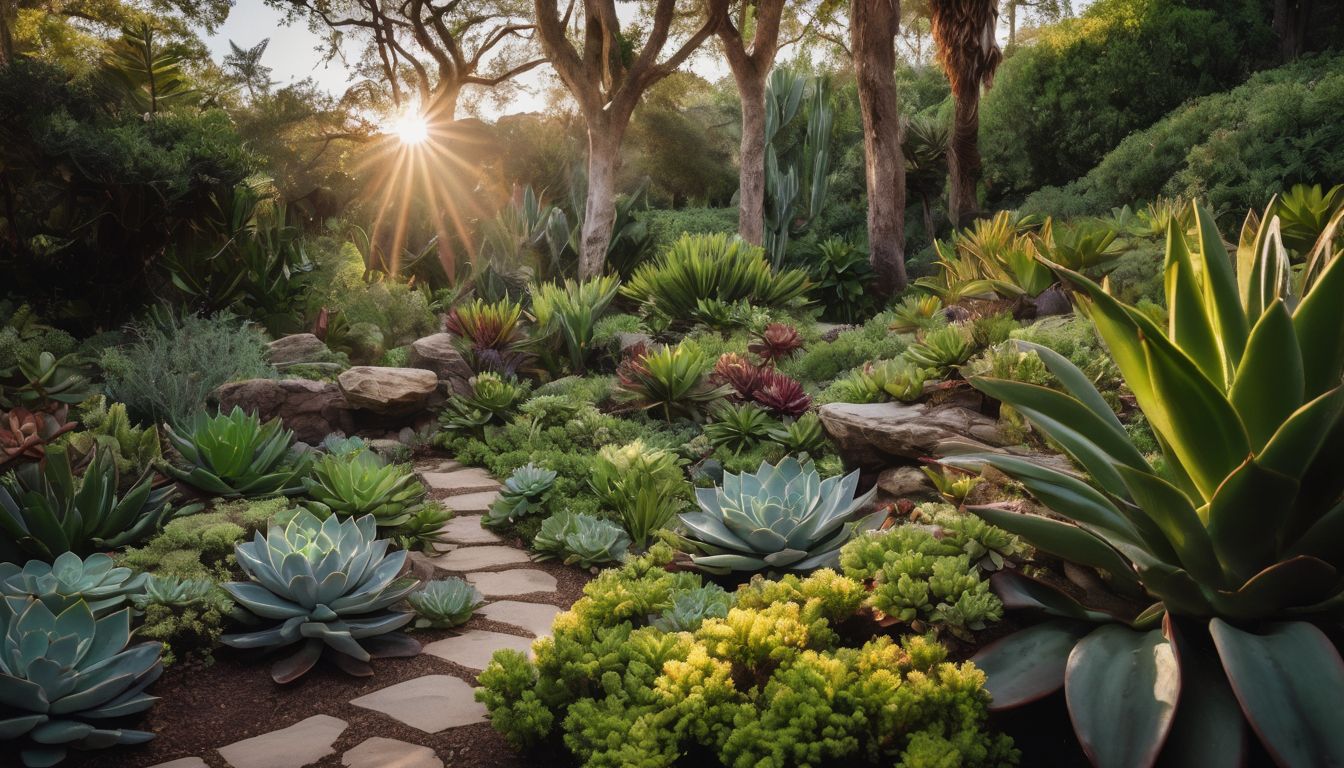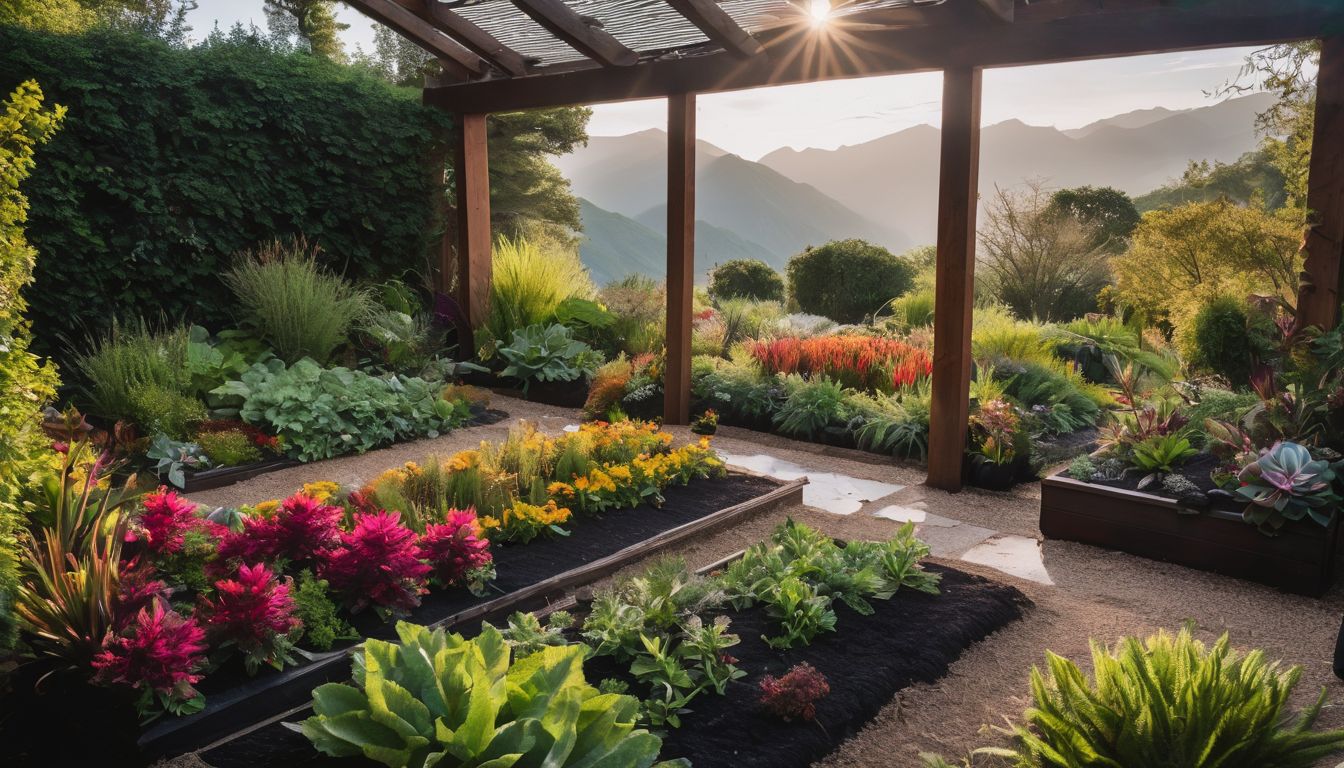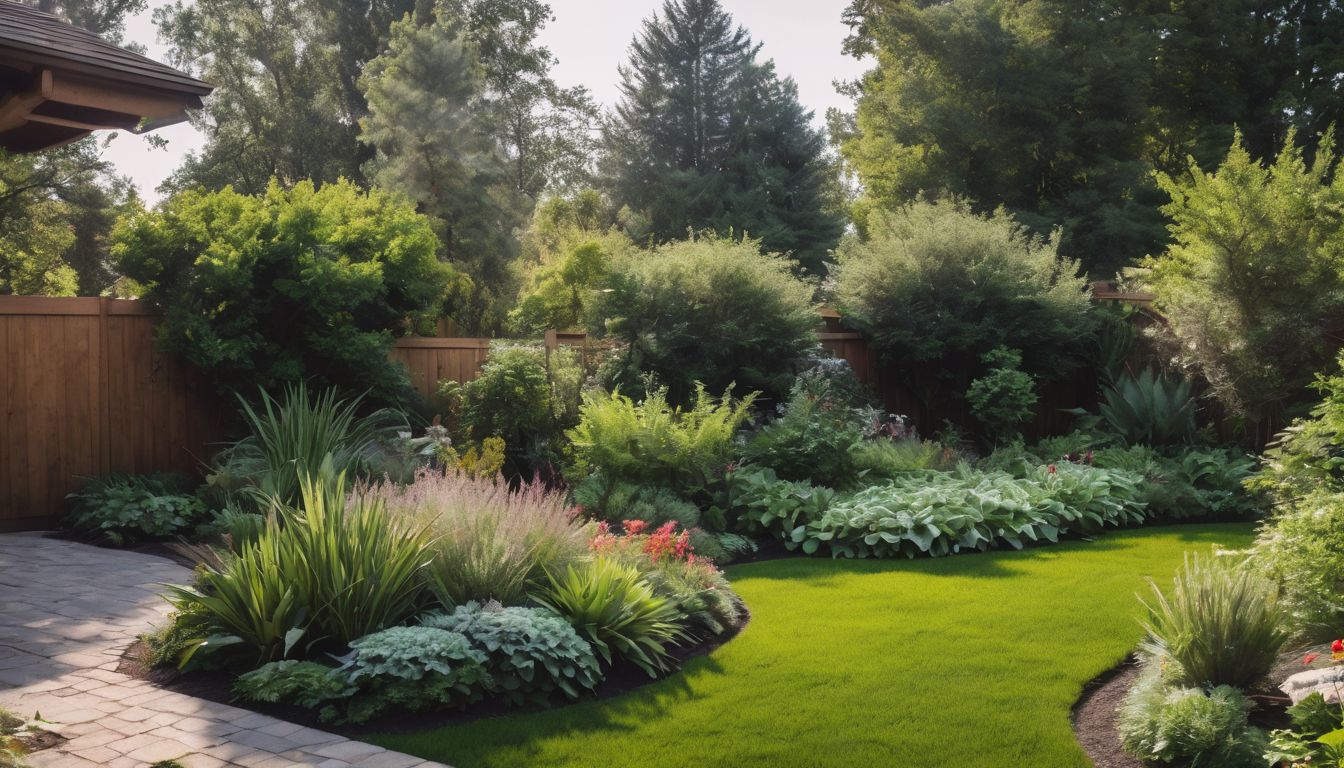Gardens are feeling the heat as climate change ramps up challenges for growers. Did you know that rising temperatures can directly impact plant growth and garden wildlife? Our blog explores practical steps to adapt your gardening practices in a warming world, ensuring your green space stays lush and vibrant.
Dive in for eco-friendly solutions!
Key Takeaways
- Gardening practices must adapt to changes such as increased temperatures and erratic precipitation due to climate change, affecting plant growth and wildlife.
- Soil carbon loss from extreme weather can reduce soil fertility; sustainable techniques like no – till gardening and mulching help maintain healthy gardens.
- Gardeners have a vital role in reducing greenhouse gas emissions through eco-friendly methods such as using renewable energy tools and planting trees for energy conservation.
- Biodiversity is crucial for a resilient garden; activities like eliminating pesticides, creating habitats for pollinators, and avoiding invasive plants support this.
- Water conservation strategies including efficient irrigation systems and rainwater harvesting are essential in adapting gardens to the impacts of climate change.
How climate change affects gardening
Climate change impacts gardening through changes in temperature and precipitation, leading to increased soil carbon loss and affecting plant growth and pollinators.
Changes in temperature and precipitation
Gardeners are noticing that plants once thriving in their local climate now struggle or require extra care. Shifts in temperature and precipitation directly influence the growing season, soil moisture levels, and plant health.
Warmer winters can encourage pests to survive year-round, placing added stress on gardens. At the same time, unexpected frosts may kill off tender shoots sprouting earlier because of warmer springs.
Increased rainfall brings challenges too, such as soil erosion and nutrient leaching which make it tough for plants to establish strong roots. On the flip side, longer droughts demand more efficient water use and smarter gardening practices to keep green spaces lush without wasting this precious resource.
Gardeners must adapt quickly to these shifts by selecting resilient plant varieties and modifying watering schedules as weather patterns evolve.
Increased soil carbon loss
As climate change intensifies, the increased soil carbon loss becomes a pressing issue for gardeners. Soil carbon is lost due to factors such as extreme weather events and changes in precipitation patterns.
These losses can lead to reduced soil fertility and decreased capacity for plants to adapt to changing conditions. Integrated strategies that focus on sustainable gardening techniques are essential for combating this challenge effectively.
Gardeners must implement practices such as no-dig gardening and mulching to promote soil health and carbon sequestration. Additionally, the use of cover crops can aid in minimising soil erosion and increasing organic matter content.
Impact on plants and pollinators
Increased soil carbon loss affects the well-being of plants and pollinators. Changes in temperature, precipitation, and evaporation can disrupt the life cycles of plants, affecting their growth patterns and survival rates.
Pollinators face challenges as they depend on specific plant species for nectar and pollen which may be impacted by extreme weather events or changes in plant cover. As a result, biodiversity is threatened as many plant and pollinator species struggle to adapt to these changing conditions.
Gardeners play an essential role in supporting the adaptation of plants and pollinators to climate change. By implementing sustainable landscaping techniques that focus on promoting biodiversity, conserving water, reducing greenhouse gas emissions, and avoiding invasive plants, gardeners can create environments that support the resilience of both flora and fauna amidst changing environmental conditions.
Gardeners’ Role in Combating Climate Change
Gardeners play a vital role in combating climate change by reducing greenhouse gas emissions, promoting biodiversity, conserving water, and managing soils. Through sustainable gardening practices, they can contribute to the overall effort of protecting the environment and mitigating the impacts of climate change.
Reducing greenhouse gas emissions
- Choosing environmentally friendly tools and equipment to reduce energy consumption.
- Using renewable energy sources, such as solar-powered lighting or water features, for sustainable gardening practices.
- Implementing composting techniques to reduce organic waste and minimise methane emissions.
- Opting for manual weeding methods instead of petrol-powered tools to lower carbon emissions.
- Installing rainwater harvesting systems to reduce reliance on municipal water supplies and save energy used in water treatment processes.
- Incorporating native plants that require less maintenance, thus reducing the use of fossil fuels in garden upkeep.
Planting trees and using landscape design to conserve energy
Planting trees and using landscape design to conserve energy is another significant way gardeners can combat climate change. Here are some key strategies:
- Introducing shade trees strategically around buildings and outdoor living areas to reduce the need for air conditioning in warmer months.
- Planting windbreaks to minimise heat loss from buildings during colder months.
- Incorporating dense plantings and well – placed trees to create microclimates that buffer against extreme temperatures, reducing the reliance on heating and cooling systems.
- Selecting native, drought – tolerant plants that require less water and maintenance while still providing insulation and shade.
- Using hardscape materials with high thermal mass, such as stone or concrete, to absorb solar heat during the day and release it at night, reducing temperature fluctuations indoors.
Promoting biodiversity and managing soils
- Introducing native plants that support local wildlife whilst reducing water usage.
- Implementing crop rotation to improve soil health and reduce the need for chemical fertilisers.
- Incorporating cover crops to prevent soil erosion and increase organic matter.
- Using compost to enhance soil fertility and microbial activity.
- Applying natural mulch to promote moisture retention and weed suppression.
- Practising integrated pest management techniques to maintain a healthy balance of beneficial insects.
Conserving water and reducing food waste
- Use drip irrigation or soaker hoses to deliver water directly to plant roots and reduce evaporation.
- Collect rainwater in barrels for use during dry spells, reducing the demand on local water supplies.
- Incorporate drought – tolerant plants into the garden landscape to minimise water usage.
- Practise mulching to retain soil moisture, suppress weeds, and maintain a more consistent soil temperature.
- Employ efficient watering techniques such as watering early in the morning or late in the evening when evaporation is lower.
- Harvest rainwater from roofs for gardening purposes through a well – designed system.
Strategies for Climate Change Gardening
Implementing no-till gardening for carbon sequestration and using mulch to improve soil health are effective strategies. Eliminating pesticide use, creating bee and butterfly friendly gardens, and promoting biodiversity are also important steps in combating climate change through gardening.
No-till gardening for carbon sequestration
No-till gardening helps sequester carbon in the soil by leaving crop residue behind, which reduces the need for ploughing and minimises soil disturbance. This practice promotes increased organic matter, improves soil structure and enhances the soil’s ability to store carbon.
By using no-till techniques, gardeners can contribute to reducing greenhouse gas emissions and mitigating climate change while maintaining healthy gardens. Integrated with cover cropping, no-till gardening also supports biodiversity by providing habitats for beneficial insects and microorganisms.
Implementing no-till gardening practices not only conserves precious topsoil but also plays a vital role in supporting sustainable horticulture methods. The approach effectively retains moisture content in the soil, minimising water evaporation during dry periods and helping plants adapt to changing precipitation patterns.
Mulching for soil health
Mulching is a beneficial technique for enhancing soil health. It helps to conserve moisture, suppress weeds, and regulate soil temperature. By using organic mulch such as straw or shredded leaves, gardeners can improve soil structure and increase microbial activity, leading to better nutrient availability for plants.
In addition, mulch acts as a protective barrier against erosion and compaction while supporting biodiversity by providing habitats for beneficial insects and microorganisms. Mulching not only reduces the need for water but also promotes carbon sequestration in the soil, contributing to climate change mitigation efforts.
Eliminating pesticide use
Eliminating pesticide use in gardening promotes biodiversity and reduces harmful chemical exposure for plants, pollinators, and the environment. It also supports beneficial insects like bees and butterflies.
This practice helps to create a healthier ecosystem by allowing natural predators to control pests while reducing the risk of water contamination from chemical runoff. Additionally, it encourages plant adaptation to resist pests naturally, contributing to a more sustainable and resilient garden in the face of climate change.
By eliminating pesticide use, gardeners can make an active contribution towards supporting conservation and environmental sustainability while promoting healthier soil and reducing harm to beneficial wildlife.
Creating bee and butterfly friendly gardens
To create bee and butterfly friendly gardens, plant a variety of native flowers to provide nectar and pollen all year round. Avoid using pesticides, as these can harm beneficial insects.
Additionally, consider adding a water source such as a shallow dish filled with pebbles for butterflies to drink from. Furthermore, leave some areas of the garden undisturbed for nesting sites and overwintering habitat.
Additionally, providing shelter in the form of dense shrubs or trees will offer protection from predators and adverse weather conditions. Remember to diversify the garden’s plant species to support different life stages of pollinators while promoting biodiversity at the same time.
Encouraging wildlife and avoiding invasive plants
By creating bee and butterfly friendly gardens, gardeners can also encourage a diverse range of wildlife to thrive in their outdoor spaces. Planting native flowers, shrubs, and trees that provide food and shelter for birds, insects, and small mammals helps support local ecosystems.
Avoiding invasive plants is crucial in maintaining biodiversity as these species can outcompete native plants and disrupt the delicate balance of local habitats. By consciously choosing native species over invasives, gardeners can contribute to the preservation of indigenous flora and fauna.
Utilising sustainable gardening practices such as avoiding chemical pesticides also plays a significant role in creating a healthy environment for wildlife to flourish. By minimising harmful chemicals within the garden ecosystem, we minimise harm towards beneficial insects like bees and butterflies while fostering an environment conducive to the survival of a variety of wildlife species.
Sustainable Gardening Techniques
Conserving water is crucial in sustainable gardening, especially during dry periods. Using manual tools and recycling/upcycling materials are also important for reducing environmental impact.
Conserving water
Saving water is crucial for sustainable gardening practices. Efficiently using water not only reduces your water bill but also helps to conserve one of our most precious resources. Here’s how you can conserve water in your garden:
- Install a drip irrigation system or soaker hoses to deliver water directly to the roots of plants, reducing evaporation and runoff.
- Collect rainwater in a barrel or cistern to use for watering your garden during dry spells.
- Group plants with similar watering needs together to ensure efficient use of water.
- Use mulch around plants to reduce evaporation and maintain soil moisture.
- Choose drought – resistant plant varieties that require less water to thrive.
Composting
Composting is a sustainable method for reducing food waste and enriching soil with essential nutrients. It helps to close the loop on organic matter, promoting a healthy ecosystem. Composting can be achieved through the following techniques:
- Collect all suitable organic waste, such as fruit and vegetable scraps, coffee grounds, eggshells, and yard waste.
- Create a compost pile or bin in a suitable location that receives adequate sunlight.
- Layer green materials (nitrogen-rich) like food scraps with brown materials (carbon-rich) such as leaves or cardboard.
- Turn the compost pile regularly to aerate it and assist in decomposition.
- Monitor the moisture levels and add water if necessary to keep the compost damp but not waterlogged.
- After several months, when the compost becomes dark, crumbly, and has an earthy smell, it is ready to use as a nutrient-rich soil amendment for gardens or potted plants.
Using manual tools and recycling/upcycling
To support conservation and environmental efforts in gardening, consider using manual tools to reduce reliance on energy-consuming equipment. Additionally, incorporating recycling and upcycling practices can minimise waste and promote sustainability. Here are specific strategies for integrating these techniques into your gardening routine:
- Utilise hand tools such as pruners, loppers, and weeders to minimise the use of power – operated machinery, reducing carbon emissions and energy consumption.
- Repurpose materials like old containers, pallets, or broken garden tools for new purposes instead of discarding them, contributing to a circular economy and reducing landfill waste.
- Embrace composting as a way to transform organic kitchen scraps and yard waste into nutrient-rich soil amendments, diverting organic matter from landfills and enriching the garden ecosystem.
- Reuse materials like plastic bottles, jars, or timber by turning them into planters, birdhouses, or garden borders through creative upcycling projects that give a second life to discarded items.
- Opt for non-disposable alternatives such as fabric or metal garden gloves instead of single-use plastic options to reduce waste generation and support eco-friendly practices.
- Employ rainwater harvesting systems using simple barrels or gutters to collect roof runoff for watering plants, conserving water resources and reducing reliance on municipal supplies.
- Implement DIY projects like building raised beds from salvaged wood or constructing trellises from repurposed wire fencing to minimise the need for newly manufactured materials while adding character to your garden space.
Conclusion
Gardening is significantly impacted by climate change, affecting temperature, precipitation, and soil health. As gardeners, it’s crucial to take an active role in combating climate change through sustainable practices.
By implementing strategies like no-dig gardening and prioritising water conservation, gardeners can positively contribute to environmental conservation. Sustainable gardening techniques such as composting and encouraging wildlife also play a vital role in mitigating the impact of climate change on gardening.
FAQs
1. How does climate change affect my garden?
Climate change can make your garden face temperature changes, unexpected precipitation shifts, and more evaporation. It affects how plants grow and survive.
2. What can I do to help my garden deal with extreme weather?
Plant cover crops to protect the soil and consider water conservation methods to manage during dry spells or heavy rainfall.
3. Will the number of pollinators in my garden change because of climate change?
Yes, climate change impacts pollinator support by changing when flowers bloom and altering habitats, which may decrease pollinator numbers.
4. Is there a way my garden can help combat climate change?
Your garden can fight against Climate Change by boosting soil carbon storage which captures greenhouse gases from the air.





